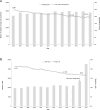Diagnosis of Helicobacter pylori infection: serology vs. urea breath test
- PMID: 39329478
- PMCID: PMC11540150
- DOI: 10.1128/spectrum.01084-24
Diagnosis of Helicobacter pylori infection: serology vs. urea breath test
Abstract
The objective of the study was to ascertain an optimal Helicobacter pylori diagnostic strategy using population-level laboratory data comparing the performance of serology against urea breath test (UBT). H. pylori diagnostic test results for serology and UBT from two laboratories over a 12-year period (2006-20017) were extracted, linked, and analyzed. A subset of this population underwent both methods of testing within days of each other, enabling a direct comparison of the two methods. The average prevalence of H. pylori positivity was 21.3% by serology and 17.5% by UBT. There were 2,612 individuals who had serology performed first, followed by UBT within 14 days. For this subset, the sensitivity of serology compared with UBT was 96.5% with a specificity of 79.2%. The negative predictive value for serology was 98.4%. Contrary to various recent clinical guidelines, the data show that serology still has utility as a sensitive enough test to be used as an initial H. pylori screening test in a lower prevalence population. Negative serology can be used with confidence to rule out active infection, whereas a positive serology could be followed up with a UBT or a similar performing test such as stool antigen to differentiate active from past infection. For population-based diagnostic recommendations, such a strategy may be ideal since serology generally costs less than UBT and may be combined with a blood draw being done for other diagnostic tests. Continuing to offer serology increases options for patients and may provide economic benefits for single-payer health care systems or health maintenance organizations.
Importance: This study compares the performance of serology with urea breath test in the diagnosis of Helicobacter pylori in a population-level data set and mimics a head-to-head direct comparison as the study population had both tests performed within 2 weeks of each other. This provides new information supporting the use of serology in a diagnostic algorithm. There are several instances where serology could be preferable to patients to rule out disease, despite some guidelines suggesting serology should not be used.
Keywords: Helicobacter pylori; serology; urea breath test.
Conflict of interest statement
The authors declare no conflict of interest.
Figures

References
Publication types
MeSH terms
Substances
LinkOut - more resources
Full Text Sources
Medical
Miscellaneous

